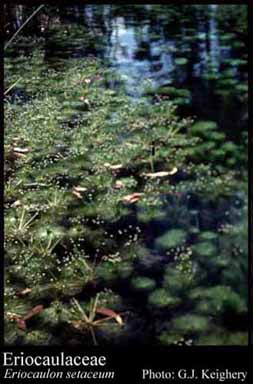- Reference
- Tekhno-Bot.Slovar 237 (1820)
- Name Status
- Current

Scientific Description
Common name. Pipewort Family.
Habit and leaf form. Herbs. Perennial (usually small); plants with a basal concentration of leaves. Helophytic. Leaves alternate; spiral (usually), or distichous (rarely); ‘herbaceous’, or leathery, or membranous; sessile; sheathing (but at the base only). Leaf sheaths with free margins. Leaves simple; epulvinate. Leaf blades entire; flat, or folded, or solid (or canaliculate); linear (grasslike); parallel-veined; without cross-venules. Leaves eligulate. Leaf blade margins entire. Vegetative anatomy. Plants with silica bodies (in the subepidermal cells in Paepalanthus), or without silica bodies. Leaf anatomy. Guard-cells ‘grass type’. Stem anatomy. Secondary thickening absent.
Reproductive type, pollination. Fertile flowers functionally male and functionally female, or functionally male, or functionally female. Unisexual flowers present. Plants monoecious (usually), or dioecious (rarely). Female flowers with staminodes (vestigial). Male flowers with pistillodes. Floral nectaries present (Eriocaulon), or absent (the rest). Nectar secretion in Eriocaulon, from the perianth (from the mouth or the inside of the perigone tube). Anemophilous, or entomophilous.
Inflorescence and flower features. Flowers aggregated in ‘inflorescences’; in heads; not in ‘spikelets’. The terminal inflorescence unit racemose. Inflorescences scapiflorous; terminal; with involucral bracts; pseudanthial. Flowers bracteate; minute, or small; regular to very irregular; when irregular, zygomorphic. The floral asymmetry when present, involving the perianth and involving the androecium (not K). Flowers 2 merous, or 3 merous; cyclic. Floral receptacle developing an androphore, or with neither androphore nor gynophore. Perigone tube present. Hypogynous disk absent. Perianth with distinct calyx and corolla, or sepaline (the corolla sometimes small, vestigial or missing in female flowers); 4–6; 2 -whorled (usually), or 1 -whorled; isomerous; different in the two whorls. Calyx 2, or 3; 1 -whorled; polysepalous, or gamosepalous (sometimes with a basal tube or spathaceous); unequal but not bilabiate (sometimes forming a spathe), or bilabiate, or regular. Corolla 2, or 3; 1 -whorled; polypetalous (often, in female flowers), or gamopetalous (male flowers with a corolla tube); unequal but not bilabiate (the anterior petal sometimes larger than the lateral pair), or bilabiate, or regular. Fertile stamens present, or absent (female flowers, which also lack staminodes). Androecium 2–6 (2 or 4 when 2-merous, 3 or 6 when 3-merous). Androecial members adnate (to the corolla); free of one another; 1 -whorled, or 2 -whorled. Androecium exclusively of fertile stamens. Stamens 2, or 4, or 3, or 6; isomerous with the perianth, or diplostemonous; alternisepalous (when reduced to one whorl), or alternisepalous and oppositisepalous. Anthers basifixed; dehiscing via longitudinal slits; introrse; bisporangiate, or tetrasporangiate. Fertile gynoecium present, or absent (male flowers). Gynoecium 2 carpelled, or 3 carpelled. The pistil 2 celled, or 3 celled. Gynoecium syncarpous; synstylovarious; superior. Ovary plurilocular; 2 locular, or 3 locular; sessile to stipitate. Styles 1–3; free to partially joined; apical. Stigmas 2, or 3; dorsal to the carpels, or commissural (then with stylodium-like appendages inserted between the true stigmas); dry type; non-papillate; Group II type. Placentation basal. Ovules 1 per locule; pendulous; non-arillate; orthotropous.
Fruit and seed features. Fruit non-fleshy; dehiscent; a capsule. Capsules loculicidal. Seeds copiously endospermic. Endosperm not oily. Seeds with starch. Embryo rudimentary at the time of seed release; lenticular. Seedling. Hypocotyl internode absent. Mesocotyl absent. Cotyledon hyperphyll compact; non-assimilatory. Coleoptile absent. First leaf dorsiventral. Primary root ephemeral.
Geography, cytology, number of species. World distribution: mainly tropical/subtropical, concentrated in South America. X = 8, 10. 1150 species.
Economic uses, etc. Furnishes a few species sold as decorative ‘everlastings’.